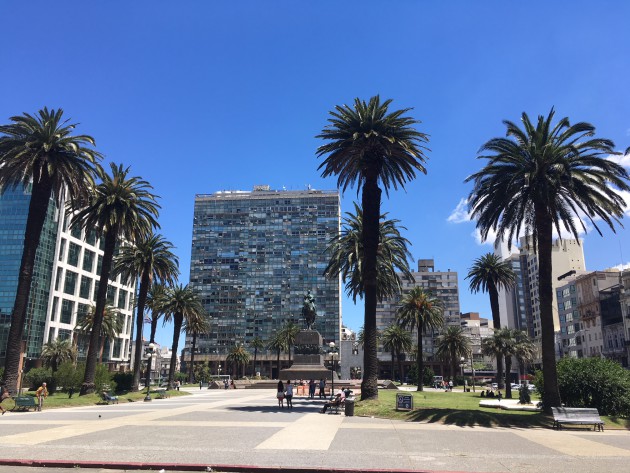
Uruguay’s winemakers target UK 'global shop window'
As an Atlantic-cooled nation of just 3.4 million people, Uruguay and its winemakers are keenly aware of the need to differentiate its wine offer from that of the country's major South American rivals, viewing the UK as an unrivalled platform to achieve that aim.
Precisely how to achieve that goal, though, is a matter of debate, as Harpers discovered on a recent trip to the country. However, what most producers do agree is that Uruguay needs to collectively push a premium message, rooted in European-leaning styles and quality-focused, smaller scale wines – and broaden the message beyond Tannat.
With 7,000 ha under vine (a third of which is planted to flagship grape Tannat), the country’s production lags far behind the voluminous output of Argentina and Chile, comprising mainly of 20ha to 30ha family-run wineries, with Brazil and USA the leading export markets, along with a small but growing presence in European markets including the UK.
“We need to differentiate between us and Argentina and Chile,” said Santiago Deicus of Establecimiento Juanicó, one of the leading producers in terms of fine wine volumes.
“What works for us is to make the link between New and Old world,” he continued, while adding that “Uruguay should start with our flagship [Tannat], but let the export markets know about the diversity beyond that”, focusing on the patchwork of differing terroirs and varieties that make up a majority of its production.
Export drive
The will for Uruguay to export has been accelerated by a severe decline in domestic consumption, falling from 50Lto 22L per head per annum in the past few decades.
However, during the same period - partially in response to greater exposure to feedback from export markets, along with a generation of winemakers that are better qualified and better travelled – there has been both a trend towards more restrained styles reflective of the Atlantic-influenced climate and also a host of varieties being championed beyond Tannat.
Overseas and domestic-backed investments in vineyards and wineries, ranging from well-established Narbona in Colonia and the more recent Vina Eden near the upmarket resort of Punta del Este, plus the billionaire-backed Bodega Garzon in Maldonado, have helped put new regions on the map and given a welcome boost to export muscle. (Argentine, Chilean and Brazilian investors are making their mark.)
Exports are up, but bulk wine forms a significant portion of that increase, which is something that Uruguay’s producers are now at pains to overturn, believing that this is an unsustainable area for a country comprised of typically small-scale producers.
Meanwhile, the growing roster of (again, often small production) alternative varieties to Tannat are seen as part of spearheading awareness of Uruguay’s diversity and quality focus. Varieties as diverse as Cabernet Franc, Petit Verdot, Nero d’Avola, Sangiovese, Marsanne, Petit Manseng, Riesling, and many others beside are all producing some very confident – and restrained – styles of wine.
“England is awakening to Uruguay right now,” said Fabiana Bracco, export manager at Narbona, whose wines are brought in through Hispamerchants in the UK and gaining listings at high-end on-trade outlets such as Caprice Holdings.
Asked whether the country’s exports to the UK and elsewhere had reached a tipping point in terms of recognition, Bracco added: “I am worried that Uruguay is not reacting fast enough to [it’s gains], we need to focus on the top wines and winemakers – after the US, the UK should be a our top market, we need to focus more on our quality and be stronger in that aim.”
The arrival of Bodega Garzon may well prove a game changer for Uruguay. Having raised a few eyebrows in the industry as the project took shape, the majority of producers now accept that such a well-financed estate, dedicated to quality production, and with good distribution channels into major export markets around the world, is a serious plus for building the image of Uruguayan wines.
Cristobal Urzua, marketing manager at Garzon, confirmed that exports from the winery had been growing fast in USA, Brazil and Europe, with healthy uptake in the UK on-trade in the year since its official launch in 2016.
Martin Lopez, who represents Uruguayan wines on behalf of government body INAVI, added: “The UK remains a very important market for any country that wants to have its wines taken seriously in other markets around the world, especially in Asian countries, and we are committed to showing the diversity of Uruguay through the on-trade and independent merchants, where the styles and qualities of the wines can be best explained.”
A fuller report on Uruguay’s wines and industry will appear in Harpers in the new year.
Keywords:
- wine
- Producers
- export
- South America
- Tannat
- varieties
- Uruguay
- INAVI
- Narbona
- Garzon
- Eden
- Vina
- Bodega
- Santiago Deicus
- Juanico
- Fabiana Bracco
- Martin Lopez




